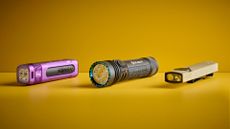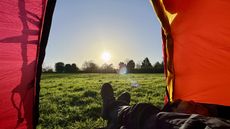Active
The latest Active breaking news, comment, reviews and features from the experts at T3
Explore Active
-

Garmin could be about to revive a forgotten wearable category – and it makes perfect sense
A new Vivosmart could signal Garmin’s quiet return to a category most brands walked away from
By Matt Kollat Published
-

MSR Hubba Hubba LT2 review: a classic backpacking tent, reinvented
After 21 years, the iconic Hubba Hubba has had a major update
By Pat Kinsella Published
-

Skip the gym – a Pilates instructor shares a six-move full-body workout to build strength all over
You just need a light pair of dumbbells, or water bottles
By Bryony Firth-Bernard Published
-

Smart rings promised a wearable revolution – now they’re fighting to stay relevant
The smart ring market has cooled, but the next phase could decide its long-term future
By Matt Kollat Published
-

Your best fitness years might come later than you think
Why consistency, not peak performance, now defines modern fitness
By Matt Kollat Published
-

You only need a dumbbell and these six exercises to build stronger legs and glutes
Aren't up to leaving the house to hit the gym? We've got you
By Bryony Firth-Bernard Published
-

Best under-desk treadmills 2025: work yourself fit
Buying Guide The best under-desk treadmills to keep you fit when you’re at your desk
By Bryony Firth-Bernard Last updated
Buying Guide -

Best camping mat 2025: inflatable and foam sleeping pads ranked
We select the best camping mats for every occasion, from self-inflating pads to cheap and cheerful roll mats
By Matt Kollat Last updated
-

Best cooler for camping 2025: keep your food and drinks cool and fresh
Browse the best cool boxes, cool bags and electric coolers for camping, festivals, picnics and balmy days at the beach
By Matt Kollat Last updated
-

Best head torch 2025: hands-free illumination on the trail
Discover the best head torch for brighter paths when you're hiking, running, camping or exploring in the dark
By Matt Kollat Last updated
-

Best waterproof jackets 2025: coats to weather any storm
Waterproof shells to keep you dry, whatever the weather
By Matt Kollat Last updated
-

Best gym bag 2025 fit for gym kings and queens
The best gym bags will help you carry around your sweaty workout gear in style
By Bryony Firth-Bernard Last updated
-

Best rowing machine 2025 for a full-body workout at home
The best rowing machines to buy today, from top brands including NordicTrack, WaterRower, Hydrow and more
By Bryony Firth-Bernard Last updated
-

Best camping bed 2025: sleep soundly anywhere
Sleeping outdoors doesn't have to be uncomfortable – the best camping beds help you enjoy a sound, restful night's sleep
By Matt Kollat Last updated
-

Best torch 2025: illuminate your way through the dark
Get the best torch for camping, night hiking, walking the dog or finding your way in a power cut
By Matt Kollat Last updated
-

Best elliptical trainer 2025 for a joint-friendly full-body workout at home
The best elliptical trainers for limb-twitching, cardio-pumping workouts at home
By Bryony Firth-Bernard Last updated
-

Keen Seek Trail Running Shoes review: A confident move into running
Hiking hoof gurus Keen have jumped feet first into the trail-running space – but is the new Seek shoe any good?
By Pat Kinsella Published
-

A stretchologist says these three moves performed daily will transform your posture
They'll take you no more than 10 minutes
By Bryony Firth-Bernard Published
-

A surprise Garmin update fixes more than anyone expected – and a mystery omission
A new software release brings improvements to high-end models, though not every watch is invited to the update party
By Matt Kollat Published
-

7 genius camping hacks an outdoor expert swears by
From turning your water bottle into a lantern to warming cold feet – here's how you can make your outdoor adventure easier
By Bryony Firth-Bernard Published
-

Best triathlon watches 2025: Top multisport picks for every athlete
I've tested the best triathlon watches of 2025 from Garmin, Polar, Suunto and Coros that helped me improve performance and recovery every step of the way
By Matt Kollat Last updated
-

Garmin’s next era starts in 2026 and the clues are hiding in plain sight
After pushing boundaries with MicroLED watches and a wave of new launches, Garmin now needs to deal with its AI questions, app drama and shifting user expectations
By Matt Kollat Published
-

Best folding treadmills 2025 to get you fit with limited space at home
The best folding treadmills can boost your cardio and pack away neatly when not in use
By Bryony Firth-Bernard Last updated
-

Best cheap treadmills 2025: Maximum cardio effort for minimal price
The best cheap treadmills for those who want to get and stay fit indoors without breaking the bank
By Bryony Firth-Bernard Last updated
-

Peloton boss explains why Tread+ isn't in the UK or Europe – and it actually makes sense
The Row+ has less of a good reason
By Britta O'Boyle Published
-

Best weight benches 2025: elevate your home workouts to the next level
The best weight bench for home workouts, from simple flat benches to adjustable home gym platforms
By Bryony Firth-Bernard Last updated
-

Boost your metabolism and build total body strength with this five-move dumbbell workout
This 25-minute EMOM workout will leave your heart racing and muscles pumped
By Bryony Firth-Bernard Published
-

Hilleberg Soulo Red Label Tent review: a gold standard in portable resilience
Unshakeable camping performance for adventurous adventurers
By Derek Adams Published
-

The Stinson One7 shows HOKA is rethinking one of its wildest shoes
The new shoes feature street-ready hybrid with translucent uppers, oversized branding and upgraded tech
By Matt Kollat Published
